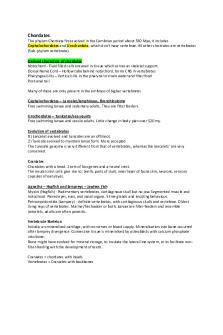MKTG1001 - lecture 12 PDF

| Title | MKTG1001 - lecture 12 |
|---|---|
| Author | Kayla Pendrick |
| Course | Foundations of Marketing |
| Institution | University of Newcastle (Australia) |
| Pages | 4 |
| File Size | 62.6 KB |
| File Type | |
| Total Downloads | 43 |
| Total Views | 116 |
Summary
Lecture notes...
Description
MKTG1001-Lecture 12
SWOT – Strengths, Weaknesses, opportunities, threats. It is an evaluation of the business that evaluates projected growth, assess competitors, and makes a realistic assessment of your business.
-
Good for planning, goals and strategies to work out what a problem, what is an opportunity etc.
-
Aids in decision making. Example – a business may decide to build a weak area to pursue an upcoming opportunity
-
Good swot analysis needs multiple perspectives to add value to the business.
SWOT factors Sit into Internal and external analysis: - need to have a realistic perspective. Internal: Strengths and weaknesses External: opportunities and threats Positive – Strengths and opportunities Negative: Weaknesses and threats
INTERNAL ANALYSIS: Strengths are positive attributes which can be tangible or intangible and are within the control of the organisation. Weaknesses are factors that may hinder the achievement of desired goals.
EXTERNAL ANALYSIS: Opportunities and threats are measured as a part of external analysis. Opportunities present themselves as attractive factors that can propel or positively influence the company in some way. Threats are external factors that could place the organisations goals at risk.
STRENGTHS: what are we good at relative to our competitors? WEAKNESSES: what are we bad as compared to our competitors OPPOURTUNITY: what changes are creating new options for us? THREATS: what emerging dangers must we avoid or counter
Marketing research: To create value and build relationships with customer… we need to know the customers insights. Need systems in place to understand these insights. We have so much information but the systems help to clear the information and choose what is most helpful towards the brand. -
How much time they spend on website
-
Where are they from
-
What they look at etc.
Big data: The huge complex data sets generated by todays information generation, collection, storage and analysis technologies. Opportunities and challenges: -
Companies that use it can gain rich, timely customer insights.
-
Asccessing and sifting through so much data is daunting.
Market analytics: - RESEARCH KAYLA! Involves tools and technologies used in making sound
Internal data: internal data collected and obtained that provide a competitive advantage. Access to data when in the field allows salespeople to be more effective.
Competitive marketing intelligence: Systematic monitoring collection and analysis of publicly information about consumers, competitors, and developments in the marketing environment. -
Helps to gain insights how consumer talk about and connect with their brands.
Marketing research: -
A design collection and analysis and reporting of data relevant to a marketing situation facing an organisation.
Define research objectives – develop research plan for collecting information. – implementing the data – report the findings.
3 broad types of marketing research: 1. Exploratory – explore and capture information 2. Descriptive – used to better describe marketing problems, situations, or markets 3. Casual – used to test hypotheses about cause-and-effect relationships.
Managers often start with exploratory and then follow with descriptive or casual research. Research is really expensive: time and money.
Develop research plan next: Secondary data (already exists data) and primary data (information that we have collected).
Secondary data: THINK ABOUT ALL OF THESE WHEN RESEARCHING! Relevance – Accuracy (reliable)– currency (How up to date it the source)– impartiality (Objectively collected and reported)
Qualitative research: explores underlying reasons for consumer behaviour. Quantitative research: delivers numerical data such as: -
number of users and purchases
-
attitudes and knowledge
-
exposure to ads
Approaches include: -
surveys
-
experimental research
-
observation – set list of things to observe etc....
Similar Free PDFs

MKTG1001 - lecture 12
- 4 Pages

MKTG1001 - Marketing Assessment
- 4 Pages

MKTG1001 - Teamwork Essay
- 4 Pages

12 - Lecture notes 12
- 3 Pages

Lecture notes, lecture 12
- 9 Pages

Lecture notes, lecture 12
- 7 Pages

Lecture 12
- 7 Pages

Lecture 12
- 3 Pages

Chapter 12 - Lecture notes 12
- 4 Pages

Lab 12 - Lecture notes 12
- 5 Pages

LEC 12 - Lecture notes 12
- 3 Pages

(12) Mistake - Lecture notes 12
- 8 Pages

Chapter 12 - Lecture notes 12
- 9 Pages
Popular Institutions
- Tinajero National High School - Annex
- Politeknik Caltex Riau
- Yokohama City University
- SGT University
- University of Al-Qadisiyah
- Divine Word College of Vigan
- Techniek College Rotterdam
- Universidade de Santiago
- Universiti Teknologi MARA Cawangan Johor Kampus Pasir Gudang
- Poltekkes Kemenkes Yogyakarta
- Baguio City National High School
- Colegio san marcos
- preparatoria uno
- Centro de Bachillerato Tecnológico Industrial y de Servicios No. 107
- Dalian Maritime University
- Quang Trung Secondary School
- Colegio Tecnológico en Informática
- Corporación Regional de Educación Superior
- Grupo CEDVA
- Dar Al Uloom University
- Centro de Estudios Preuniversitarios de la Universidad Nacional de Ingeniería
- 上智大学
- Aakash International School, Nuna Majara
- San Felipe Neri Catholic School
- Kang Chiao International School - New Taipei City
- Misamis Occidental National High School
- Institución Educativa Escuela Normal Juan Ladrilleros
- Kolehiyo ng Pantukan
- Batanes State College
- Instituto Continental
- Sekolah Menengah Kejuruan Kesehatan Kaltara (Tarakan)
- Colegio de La Inmaculada Concepcion - Cebu


